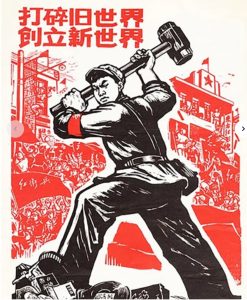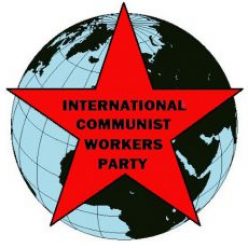
Poster reads: “Shatter the old world, build the new world.”
It is long overdue that we face the question: When did the Soviet Union turn revisionist?
Understanding when and how the Soviet Union turned revisionist is vital for today’s struggle. Only by learning from this history can we ensure that the International Communist Workers’ Party never repeats those errors — and continues the fight directly for communism, without illusions about socialism, democracy, or alliances with the capitalist class.
It’s also vital to realize that communism is not Soviet revisionism. This is especially important in Europe, where many even on the left believe that communism was tried in the USSR and failed.
An article in the last Red Flag said: “But history has shown that it was the communists of the old Soviet Union, under Stalin’s leadership, who defeated Hitler’s fascist hordes, thus dismembering European fascism.”
There are serious problems with this statement. It assumes that the Red Army of 1939 was an army of communists. Yet by 1944–45, that same army was installing openly revisionist regimes across Eastern Europe. Both cannot be true. The reality is that the Soviet Union had already turned revisionist in the 1930s and by 1939 was no longer communist in any sense.
This is a hard fact. It means millions died in World War II, not to build communism but to expand a state-capitalist empire. The Soviet rulers abandoned revolutionary principles and replaced them with nationalism, obedience to hierarchy, and competition among imperialists. What appeared as a triumph for socialism was really the rise of social imperialism — imperialism wrapped in red flags.
The turning point came in the mid-1930s, after Hitler’s rise to power and the destruction of the German Communist Party (KPD), then the largest in Europe. Instead of analyzing that defeat and correcting revolutionary errors, the Soviet leaders turned sharply rightward. They chose alliances with “anti-fascist” capitalists and social democrats over mobilizing the working class for communism.
The Comintern’s 1935 adoption of the United Front Against Fascism sealed this shift. The struggle for communism was replaced by a campaign for “democracy.” In practice, this meant alliances with the same social-democratic traitors who had betrayed the workers’ movement. In the United States, it meant supporting Roosevelt’s New Deal. In France, joining the Popular Front. In Spain, backing the bourgeois Republicans instead of fighting for workers’ power.
Worse, the Soviet Union allied with imperialist powers themselves—first the western “democracies,” then fascist Germany through the Nazi-Soviet Pact of 1939, and later the western Allies after Hitler’s invasion. These maneuvers showed the total abandonment of proletarian internationalism in favor of national interest and imperial rivalry.
Inside the Soviet Union, revisionism reshaped everyday life. Abortion and same-gender relationships were outlawed. Divorce was made difficult. Military ranks and medals returned. Revolutionary Marxist education was replaced by rigid, Prussian-style schooling with exams, grades, and segregation by age and gender.
This was not communism and is not what we are fighting for. We must make this clear.
—Comrade in Canada
Read our 2017 series on the History of the Bolshevik Revolution of 1917 here

